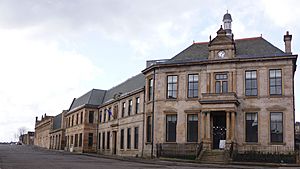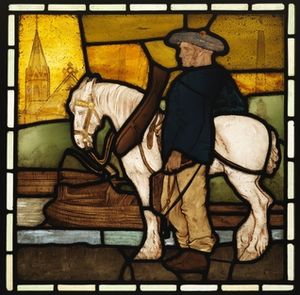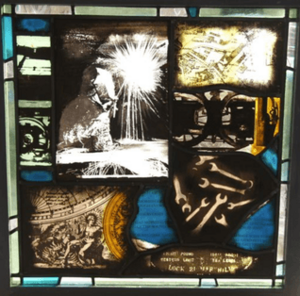Maryhill Burgh Halls facts for kids
Quick facts for kids Maryhill Burgh Halls |
|
|---|---|

Maryhill Burgh Halls
|
|
| Location | Gairbraid Avenue, Glasgow |
| Built | 1878 |
| Architect | Duncan McNaughtan |
| Architectural style(s) | Revivalist French Renaissance style |
|
Listed Building – Category B
|
|
| Official name: 10 Gairbraid Avenue, Maryhill Burgh Halls | |
| Designated | 28 February 1980 |
| Reference no. | LB32349 |
| Lua error in Module:Location_map at line 420: attempt to index field 'wikibase' (a nil value). | |
Maryhill Burgh Halls is a special historic building in the Maryhill area of Glasgow, Scotland. It's located a few miles north-west of Glasgow city centre. The halls first opened in 1878. Back then, it was a big building that included a police station and a fire station. These parts were used until the 1970s.
Later, the building became old and damaged. There were even plans to knock it down! But local people fought to save it. Because of their efforts, the halls were repaired and reopened in April 2012. Now, Maryhill Burgh Halls is a busy community hub. It offers office spaces, rooms for events, and a museum. The museum shares stories about local history and interesting topics.
The Maryhill Burgh Halls is managed by the Maryhill Burgh Halls Trust. This group was started in 2004 by people from the community. Many volunteers help run the halls every day. They also make up most of the Trust's board. Different groups use the halls, like an architecture company, a children's nursery, and a local housing association.
When the halls first opened, they had twenty beautiful stained glass windows. These windows showed people doing different jobs common in the area. The famous studio of Adam and Small made them. Today, eleven of these original windows are still on display. The rest are kept safe by Glasgow Museums. There are also ten newer stained glass panels made around 2015. These show modern themes of Maryhill, chosen by over two hundred local people!
Contents
Exploring Maryhill Burgh Halls
The Building's Story
Maryhill Burgh Halls was built because the town of Maryhill was growing fast. More people meant more need for services like a police station. A Glasgow architect named Duncan McNaughton designed the building. It was finished in 1878. The style is called French Renaissance, which looks like old French buildings. It's made from strong stone.
The building had a police station, a court room, a fire station, and even homes for the firefighters. There was also a large public hall that could hold 900 people! In 1891, Maryhill became part of Glasgow. The building then lost its main city functions but was still used for community events. A swimming pool and washhouse were added in 1898.
The police and fire stations were used until the 1970s. After that, the building became run down. People wanted to knock it down, but the community worked hard to save it. Thanks to them, Maryhill Burgh Halls was restored. It now serves the community again with offices, a museum, and event spaces. It's even a place for important discussions. For example, a political leader, Richard Leonard, launched a campaign there in 2019.
Bringing the Halls Back to Life
In 2004, the Maryhill Burgh Halls Trust was formed. Their goal was to bring the building back into use for the community. In 2006, they received £1.1 million in funding. This money helped them plan the restoration work. The main restoration happened between 2008 and 2011.
Repairs to the stone walls started in 2008 to make the building safe. More funding, about £9.2 million, was secured in 2009 after five years of hard work by the Trust. In November 2009, Glasgow City Council gave ownership of the halls, police station, and fire station to the Trust. The main restoration work began then and finished in November 2011. The halls officially reopened in April 2012.
Many groups helped fund the restoration, including the Scottish Government and the Heritage Lottery Fund. The old swimming baths were turned into a modern leisure centre by Glasgow City Council. This new centre opened in April 2010. It has a swimming pool, gym, sports hall, and dance studio for everyone to use.
Maryhill Burgh Halls Trust
The Maryhill Burgh Halls Trust owns and runs the Maryhill Burgh Halls. It was set up in November 2004. The Trust is a team effort involving local people, housing groups, Glasgow City Council, and local leaders. Anyone can apply to join the Trust. It currently has 180 members.
The Trust's board includes local residents and people who work in the area. These are people who have been active in community work for many years. They are chosen by the Trust's members at the yearly meeting.
Amazing Stained Glass Windows
When Maryhill Burgh Halls first opened, it had twenty special stained glass windows. They were taken out in 1963 and stored by Glasgow Museums. Later, they were cleaned, fixed, and reframed. Today, eleven of these old panels are back on display. There are also ten new glass panels that were made around 2015.
Historic Stained Glass Windows
The original stained glass windows were made by the Adam and Small studio in Glasgow. Stephen Adam, who started the studio, was a very famous stained-glass artist. He was born near Edinburgh in 1847.
These panels are special because they show ordinary people doing their everyday jobs in Maryhill. They are dressed in their work clothes. This was unusual at the time, as most stained glass showed religious scenes. If workers were shown, they usually wore old-fashioned or biblical clothes. One writer, Michael Donnelly, said this was "one of the most important commissions" of Stephen Adam's career. Another writer, Ian R. Mitchell, called them "world-historic" because they are such a large and realistic collection of worker portraits.
The names of some of these old panels are: The Blacksmiths, The Boatbuilder, The Bricklayers, The Canal Boatman, The Chemical Workers, The Engineers, The Glassblower, The Soldiers, and The Teacher. We don't know the exact order they were displayed in originally. Eleven of these historic windows are now at Maryhill Burgh Halls. Ten are in the main hall, and 'The Canal Boatman' is at the main entrance.
Modern Stained Glass Windows
To celebrate the restoration of Maryhill Burgh Halls, ten new stained glass windows were created. Scottish artists Alec Galloway and Margo Winning made them. The themes for these new windows were chosen by the Maryhill community. Over two hundred people gave their ideas at workshops and talks.
The chosen themes reflect important parts of modern Maryhill. They include: culture, diversity, education, heavy trades, and sport and leisure. After the designs were approved, each panel was built at Alec Galloway's workshop. Some panel titles are: Art-Beat, Playing the Game, Global Village, and Made in Maryhill. One window, 'Touching the Stars', is said to be the world's first "interactive stained glass panel." This is because it includes an active QR code in its design!
Courtyard Entrance Gates
The Maryhill Leisure Centre and Maryhill Burgh Halls share a courtyard entrance. This area used to be where the fire station was. The fire station had a three-story building above four stone archways. These archways are still there today and form the entrance to the courtyard.
To connect the past with the present, a famous Scottish sculptor named Andy Scott was asked to create four metal gates for the archways. Andy Scott also created The Kelpies in Falkirk. His metal gates for Maryhill show firefighters in old uniforms, along with old equipment and fire engines.
Maryhill Museum
The Maryhill Burgh Halls Trust wants to collect and share the history of the Burgh Halls and the Maryhill area. That's why they created a permanent museum inside the halls. The museum is a place to see local history items and for the community to display their own projects. People are encouraged to share their memories of Maryhill and learn about the area's past.
Recent Exhibitions
Fred's War 2018
This exhibition told the story of Fred Davidson, a 25-year-old medical officer in World War I. He secretly took his camera to the front line and captured some of the earliest war photos. The exhibition showed a First World War helmet, medals, maps, Fred's photos, and a camera like his.
Partick Thistle Football Club: Then and Now
From March to September 2019, the museum had an exhibition about Partick Thistle Football Club. This club was founded in 1876 and has been based in Maryhill since 1908. Their nickname is ‘The Jags’, and they play at Firhill Stadium in Maryhill.
A Flag for Maryhill
In 2020, a competition called ‘A Flag for Maryhill’ was launched. People, community groups, and schools were invited to design a flag for Maryhill. The goal was to bring the community together, think about Maryhill's history, and create a symbol of local pride. A panel of judges, including Scottish actress Jane McCarry, chose five top designs. The public then voted for their favorite. The winning flag was revealed at a community party in October 2021.
The Way We Were
In September 2020, the museum showed black and white photos by Glasgow photographer Morton Gillespie. This exhibition showed what Glasgow was like in the 1960s.
Glasgow Photo Journey 1978
From July to December 2021, an exhibition featured black and white photos by Jos Treen. He took these pictures around Glasgow in 1978. The hundreds of photos were forgotten for forty years before being rediscovered!
Loving Earth Textile Panels
From September to November 2021, the museum displayed textile panels from The Loving Earth Project. People made 30 cm x 30 cm fabric panels showing the effects of environmental damage and what we can do about it. This exhibition was held around the time of the COP26 climate conference in Glasgow.
Jo Sunshine Art
Since Autumn 2021, drawings by Jo Sunshine, a visually impaired artist from Glasgow, have been on display. After a car accident, Jo lost sight in one eye and has blurry vision in the other. Because of this, she draws everything large and uses bold colors.
Glasgow Orchestral Society
From November 2021 to March 2022, the museum had an exhibition about the Glasgow Orchestral Society. This group was formed in 1870. They have used Maryhill Burgh Halls for their weekly rehearsals since 2011.
Ghost Signs of Glasgow
From April to July 2022, the museum showed pictures and stories of ghost signs found on Glasgow buildings. A ghost sign is an old, hand-painted sign that has lasted on a building until today.
50 Pots
From July to November 2022, the museum hosted an exhibition called '50 Pots' by the Scottish Pottery Society. It covered 200 years of Scottish pottery making, including the workers, places, and products. The exhibition showed old pottery pieces and new ones made by students.
Maryhill is Wonderful
From November 2022 to April 2023, the museum featured an exhibition called 'Maryhill is Wonderful'. It showed black and white photos of people who live, work, or volunteer in Maryhill. Photographer Campbell Ramage took these pictures during the COVID lockdowns.
Strike! Stories of Bryant and May
In summer 2023, the museum will host an exhibition about Bryant and May, a company that made matches like Scottish Bluebell. This company was a big employer in the area. The exhibition shares stories from former factory workers and tells about events like the 1888 matchgirls' strike.
The Nolly Café
The Maryhill Burgh Halls has a café called 'The Nolly'. The name was chosen by public vote after the café reopened following the COVID-19 pandemic. 'Nolly' is a local nickname for the Forth & Clyde Canal, which flows behind the building.
See also




